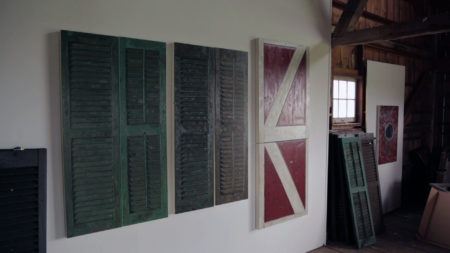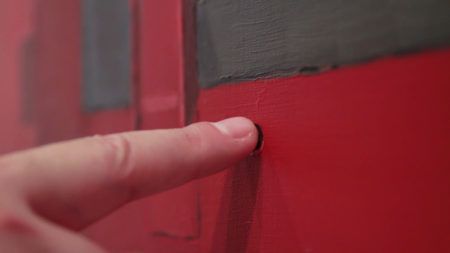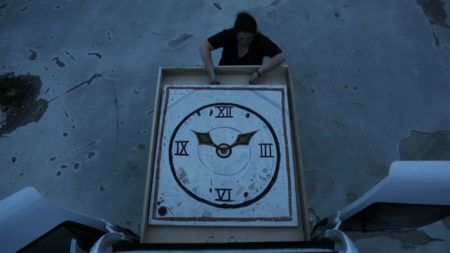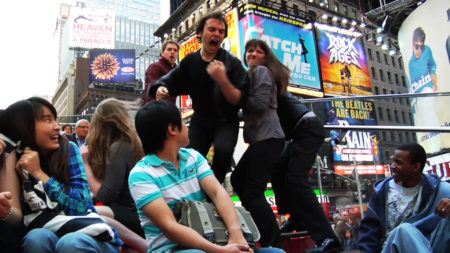Continue playing
(Time remaining: )
Play from beginning
Continue playing "{{ controller.videos[controller.getVideo(controller.currentVideo)].segmentParentTitle}}"
{{controller.videos[controller.getVideo(controller.currentVideo)].title}} has ended.
Josephine Halvorson Gets the Conversation Going
How do you make an artist? At The Cooper Union for the Advancement of Science and Art in Manhattan, artist Josephine Halvorson guides an undergraduate painting class in a group critique. The student work ranges from letterform-inspired abstractions to painterly landscapes to intensely graphic narrative scenes on shaped canvases. The paintings are the culmination of a semester’s worth of work. On guard against the students’ tendency to respond to an artist’s words as much as their work, Halvorson explains her particular critique process: “The students give feedback without the artist over-determining it initially by what they say about it.”
Her students’ comments are wide-ranging, off the cuff, and at times sharply critical. One student wonders if a densely iconographic set of paintings is an “allegorical overload,” challenging the viewer to give up on ever getting a clear understanding. For this student, the moment is poignant. This set of critiques will be one of few remaining opportunities to hear so consistently and variously from her artist-peers. Once out of school, she knows she’ll struggle to find similar chances for feedback.
A Cooper Union alumna herself, Halvorson remembers the anxiety of her own undergraduate group critique experiences and the feeling of never producing work worthy of review. Art education—premised on the hope of training someone to do a seemingly untrainable creative act—is a necessarily tricky, contradictory endeavor. But for Halvorson, group critique, with its possibility of open dialogue and exchange, is one of art school’s truly constructive models for learning.
More information and creditsCredits
Art21 New York Close Up Created & Produced by: Wesley Miller & Nick Ravich. Editor: Scott Burgess & Erin Casper. Cinematography: Christine Ng & Iva Radivojevic. Sound: Scott Fernjack, Ian Forster & Nick Ravich. Associate Producer: Ian Forster. Design: Crux Studio & Open. Thanks: Alex Barrett, Beatrice Bolton, Sarah Demoen, Jenny Eagleton, Clara Genard-Claus, Phoebe Gray, Josephine Halvorson, Taylor Hand, Minjung Jun, Matias Maunu, Emma McMillan, Daniel Schraeder, Maya Strauss, The Cooper Union for the Advancement, of Science and Art, Dylan Vandenhoeck, and Theresa Zeitz-Lindamood. An Art21 Workshop Production. © Art21, Inc. 2014. All rights reserved.
Art21 New York Close Up is supported, in part, by the New York City Department of Cultural Affairs in partnership with the City Council; The Lambent Foundation; The Andy Warhol Foundation for the Visual Arts; and by individual contributors.
Closed captionsAvailable in English, German, Romanian, Italian, Japanese, Korean, Chinese, Italian
Through the Art21 Translation Project, multilingual audiences from around the globe can contribute translations, making Art21 films more accessible worldwide.
Interested in showing this film in an exhibition or public screening? To license this video please visit Licensing & Reproduction.
Josephine Halvorson was born in 1981 in Brewster, Massachusetts, formerly worked in New York, and currently lives and works in Western Massachusetts. Combining acute attention to detail and an insistence on painting from life, Halvorson gives herself only one day to complete each canvas. Traveling outside of New York to paint, she works onsite, often selecting scenes that convey a sense of postindustrial grit. Interested in her relationship to the subjects of her paintings, Halvorson resists the term painter; she prefers to think of painting as recording time spent with an object in its environment.





